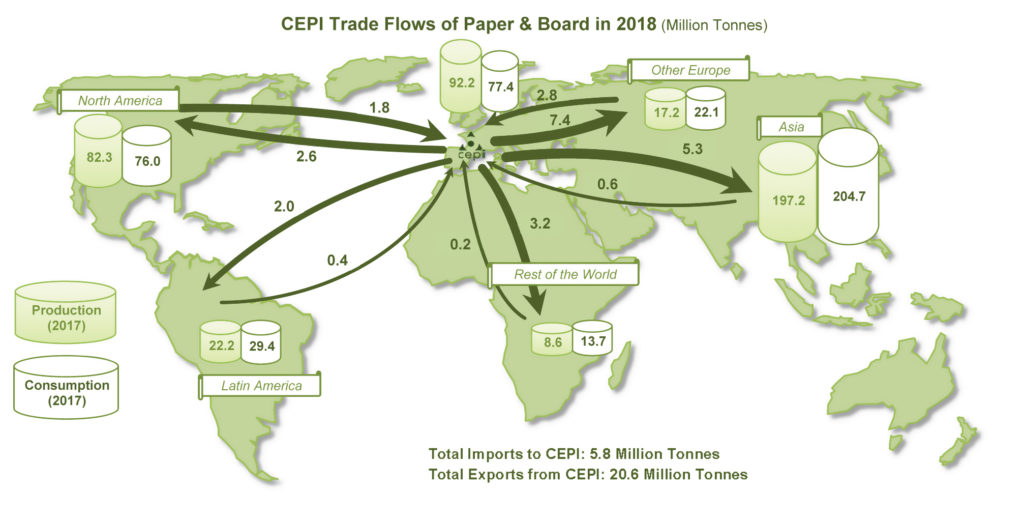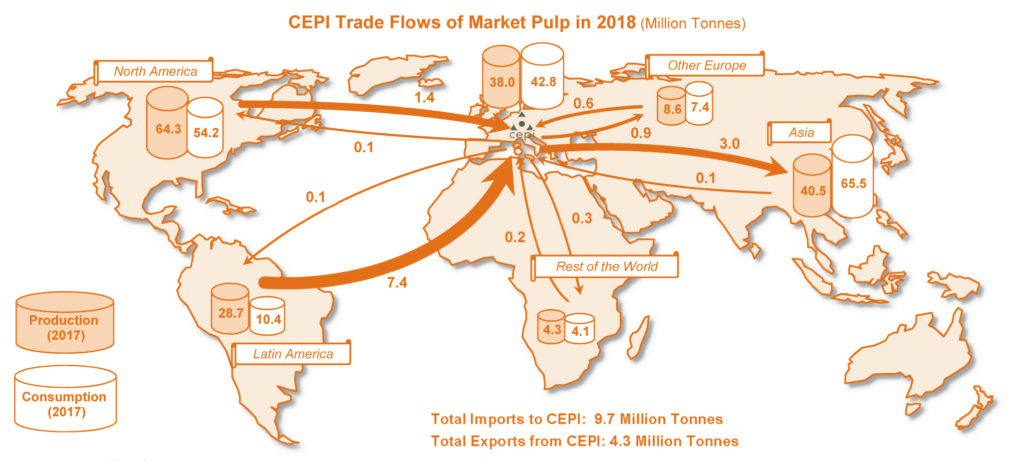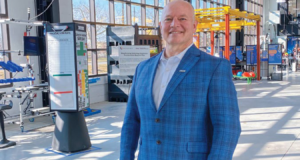MARK RUSHTON
Paper360° was recently invited to attend the Confederation of European Paper Industries’ (CEPI) annual event in Brussels, Belgium. With the theme Paper & Beyond (Our Climate, Our Solutions), the event attracted many high-level professionals from the European industry and from around the world. Mark Rushton, senior editor, took the opportunity to sit down with incoming director general of CEPI Jori Ringman to talk about the challenges and opportunities being presented in the P&P sector.

Jori Ringman has been director general of CEPI since June of last year, following the sudden loss of former director general Sylvain Lhôte. Previously, Ringman was deputy director general at CEPI and responsible for issues relating to sustainability, environment, and consumer protection, with particular emphasis on packaging and food contact issues. Since joining CEPI in 2005, Ringman has been advancing and exploring the circular, low carbon bioeconomy in Europe.
Prior to 2005, Ringman was a civil servant at the European Commission and a political advisor in the European Parliament. Before moving to Brussels, he was secretary general of civic associations, editor of a newspaper, and secretary general of a parliamentary group in his native Finland.
Ringman has a background in economics, econometrics, and business management, with broad experience in communications, public administration, and politics. He also holds an MSc in Environmental Decision-making and is trained as an executive and team coach.
Paper360°: As the incoming director general of CEPI, what are your thoughts on the challenges ahead for the European pulp and paper industries?
Ringman: We are entering a new decade with a new European Commission that has now been in office since December. The commission has announced a European Green Deal, which is a broad package of ambitious policies including climate change mitigation, but going far beyond. At the same time, we will be challenged in trade as the global trading patterns are being questioned.
And what are the challenges you see ahead for CEPI?
CEPI is traditionally a highly impactful organization with a great reputation in Brussels. The world around us is changing fast, however, and this challenges CEPI to change, too. We will need to review the way we work to remain effective and relevant for both our industry and our stakeholders.
In Brussels, we need to clarify the unique profile of our sector as renewable, recyclable, and responsible—the three key values that are now part of the revised CEPI logo for the next five years.
There appears to be a lot going on in Europe when it comes to new initiatives across the board for the forest products industries—with the overall plan to become a carbon-neutral society by 2050. Can you tell us what this means in practical terms for the pulp and paper industries in the EU?

CEPI has published a “CEO initiative” that is re-confirming our sector’s stance in supporting European society in becoming net neutral by 2050. For that to happen, however, we need to have access to our renewable raw materials—both fresh and recycled—and access to clean energy. Furthermore, the policy has to help markets distinguish between the fossil (products) and our low-carbon, renewable, recycled products to make full use of the substitution effect.
This CEO initiative is yet another milestone in the series that started with the CEPI Roadmap in 2011. It really is a journey we are taking. We are now in the process of translating the CEO initiative into a detailed work program.
Can you explain what the new European Green Deal means to the pulp and paper industries?
The European Green Deal translates to a significant step-change for the society, including pulp and paper industries. The simple recipe of papermaking is fibers plus water plus energy. In short, the Green Deal will challenge us in all those key ingredients. Many are concerned about forests and believe misguidedly that the best climate action is to protect forests. Because of the plastics pollution, recycling systems are being changed to better accommodate plastics—but will become perhaps less suited for paper.

The EU is moving toward “zero pollution,” which for sure will have implications on how we use water and treat our effluent. And we need to find ways of switching to clean energy also in non-integrated mills. In all mills, including those already running on renewables, we certainly will need to significantly reduce energy consumption, as society will need even more clean energy than will be available.
Outside of the production of pulp and paper, how important are other bio-products to the future of both industries? Is there enough innovation going on in these areas and is CEPI offering any assistance?
Other bio-products are very important for the sector. They help to diversify our product range in a way that increases the sector’s resilience. We seem to have endless opportunities in green chemistry, including in high value-added areas like food and pharmaceutical sectors. I believe lignin will become increasingly important in the future as a sought-after resource. I see very vibrant innovation work in the sector for both new fiber-based products, but also in the areas of other bio-products.
CEPI’s role is to ensure the sector has a fair share of public funding for R&D and innovation. We are also always very happy to give examples of innovative new products, processes, and new investments, which helps communicate the message that forest products is not a sunset industry, but is actively investing and re-inventing itself.
Recently, CEPI has taken the initiative to set up two forums to speed up change in the sector: In the area of new packaging-related products the “4evergreen—circular fiber forward” initiative will help identify opportunities to improve the entire system along the whole life-cycle together with companies from the extended value chain. This is expected to also result in innovative projects.
The second forum is set to find innovative energy solutions for the sector and look outside the box. Both forums are also helping to re-energize the traditional trade association way of working, making CEPI more agile and responsive to the needs of the sector.
How important are the pulp and paper industries when it comes to the bioeconomy in Europe?
We have a great advantage in having established responsible sourcing of renewable raw material that is not competing with food production and a well-functioning recycling system. In that, we are performing unlike any other bioeconomy sector today. We still have plenty of untapped potential. I believe that cellulose-based textile fibers, for instance, will become a significant business area in the near future as synthetic fibers are becoming less desirable.
According to the latest CEPI statistics, the sector employs around 180,000 people and generates some EUR20 billion (US$22 billion) in GDP every year. If you were to look 10 years ahead, what figures do you think CEPI will be reporting then?
Although we recorded an increase of 2,000 new employees in 2018, the number of people employed will probably not dramatically increase in the future. However, the tasks they perform and skills they need to have will have changed. This will also be an additional challenge for us to attract those new people to the sector.
As we aim to grow in the bioeconomy and are expected to have already taken many steps in reducing energy consumption and related cost, this should result in growing the value added in a noticeable way.
CEPI held its excellent Paper & Beyond (Our Climate, Our Solutions) event in Brussels recently. How important are events of this kind for the industry?
It is important to stop once a year to take stock, announce new initiatives, and set the bar higher for the next year. It is also an opportunity to showcase our sector to our stakeholders in Brussels.
Mark Rushton is senior editor, Europe and Asia, for Paper360°. Reach him at [email protected].
 Paper 360
Paper 360
